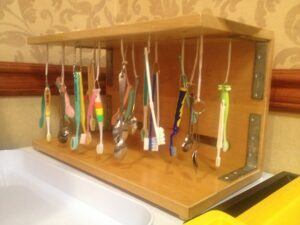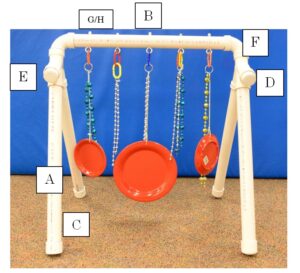Reaching
Reaching Things on the Body

The ability to reach for objects is important and something that may not happen without support for a child with limited vision or blindness or a child with physical challenges involving hands and arms. There are many activities to help a child develop the ability to coordinate the use of hands and arms to reach objects away from the body.
Of course, we begin where the child is developmentally and if they are not reaching away from their body we help them learn to reach for things on their body. Using vests and cummerbunds are one easy way to give the child something interesting to reach for in a place where their hands and arms often are positioned naturally.
Awareness of Arms and Hands
Helping the child to become more aware of his/her arms and hands is important to developing reach. During interactions with your child, offer your hands to her using a hand-under-hand technique and let her explore them. Try to engage in hand play games such as patting, clapping, and rubbing. During activities of daily living consider rubbing lotion on arms and hands. Use materials like Wrist Scarves and Velcro Gloves to increase the child’s own movement of hands and arms.



Little Room
Another great environment for developing the ability to reach for objects is the Little Room. Begin by placing the objects in the Little Room so that any attempt to move the arms and hands to interact with the object causes something to happen. Initially the child may only bat at the objects, but should eventually begin to grasp the objects and pull it towards his mouth or manipulate it with both hands.
Reaching and Grasping In a Little Room
In this video we see a child learning to reach and grasp objects in a Little Room.
Play Full Video
Downloads:
Other Activities
There are many Active Learning environments and activities that encourage the child to develop the ability to reach.

Position Boards can be very motivating for children who are just learning to reach and begin to grasp.

Any device like an Echo Bucket can motivate a child to reach objects that make noise or have interesting visual features.

Children with cerebral/cortical visual impairment may need adaptations to materials such as pegboard books or position boards to encourage them to use a visually directed reach.

It is very important to consider where objects are positioned to facilitate the child’s ability to reach and interact with it. Place objects to the side near hands and arms when the child is seated or lying down. Make sure the object will do something interesting when the child makes contact with it. For example, if tapped or banged will it make a sound or vibration? Does it have an interesting texture or temperature?
Suspending things above the child or in front of the child may motivate the child to reach. Try using things like Tabletop Mobiles or PVC Mobiles.


